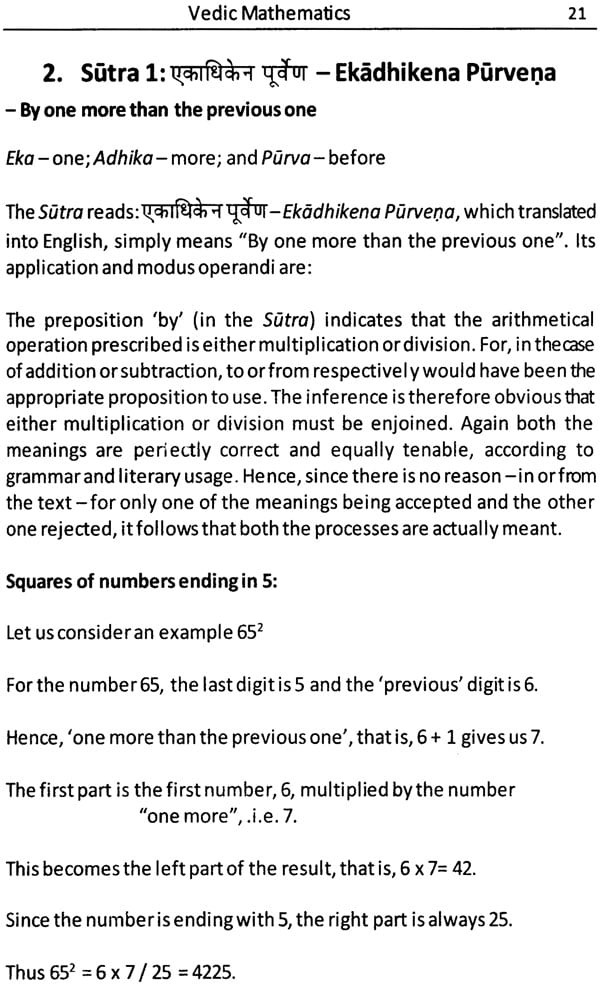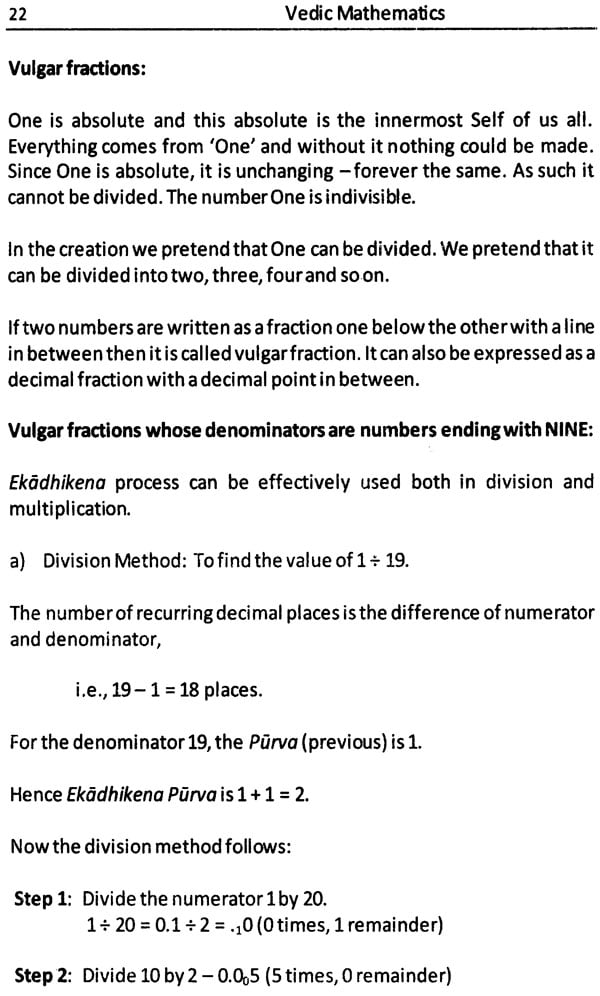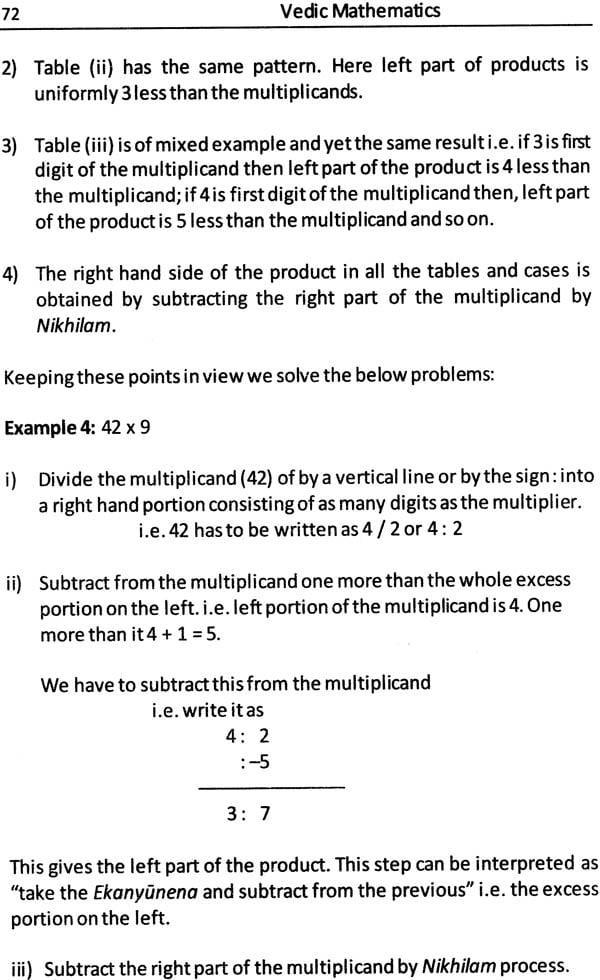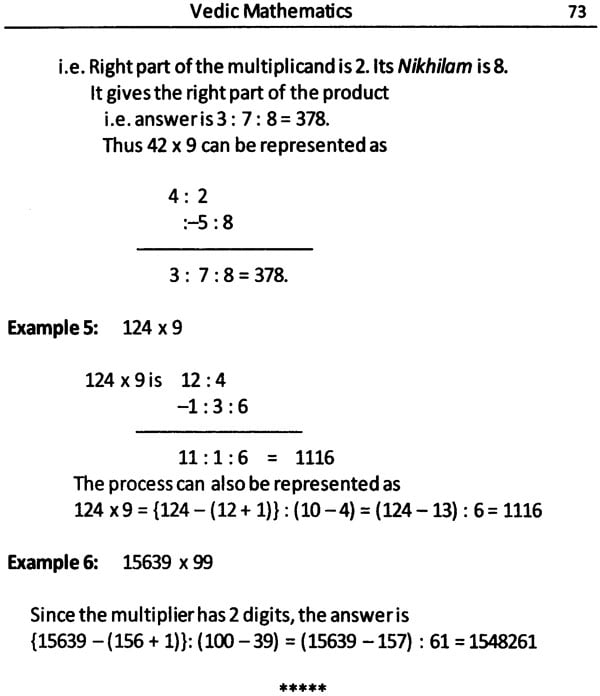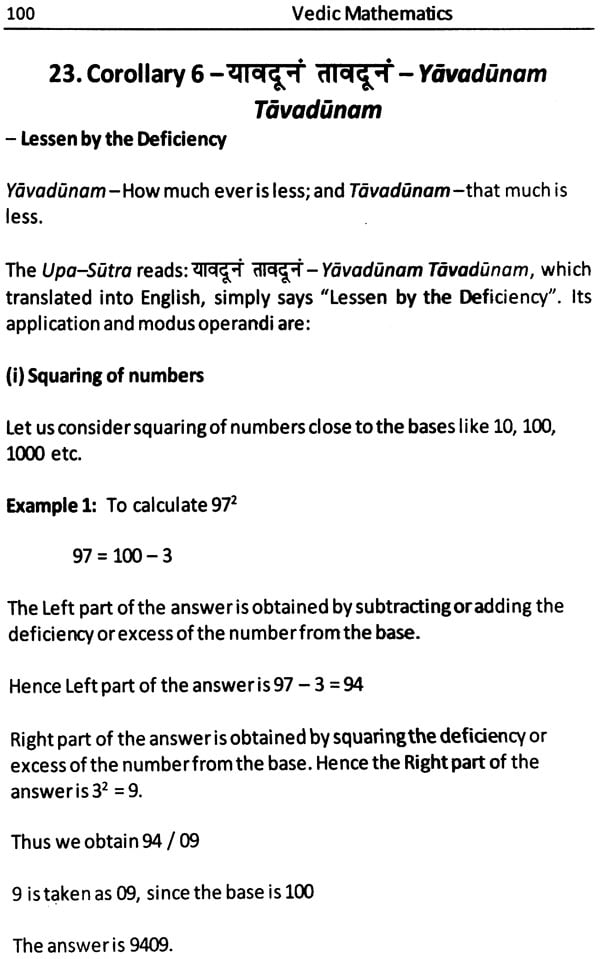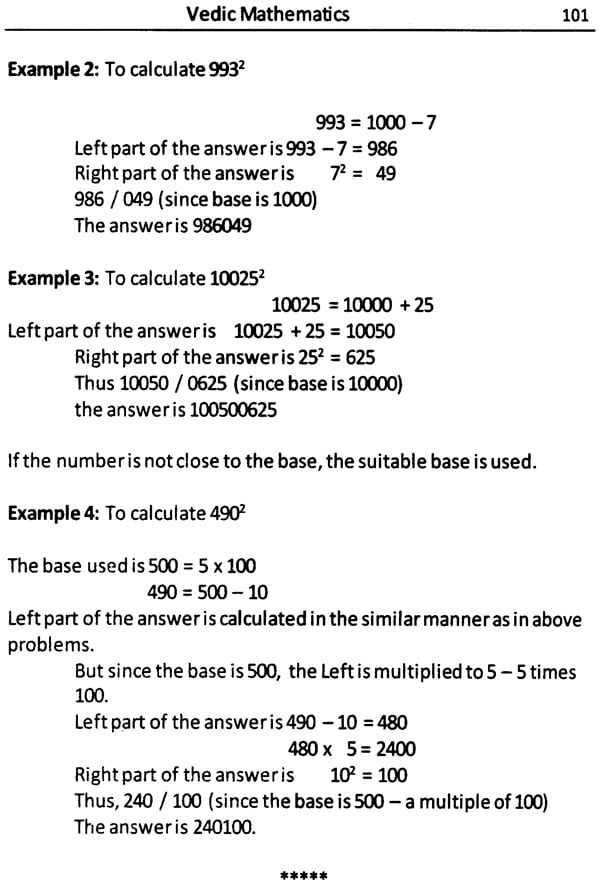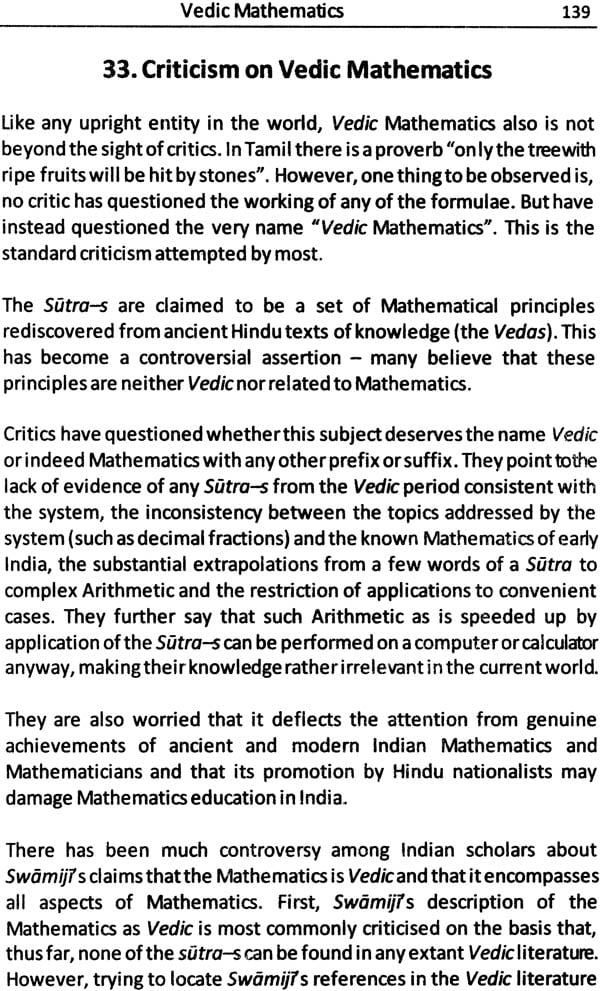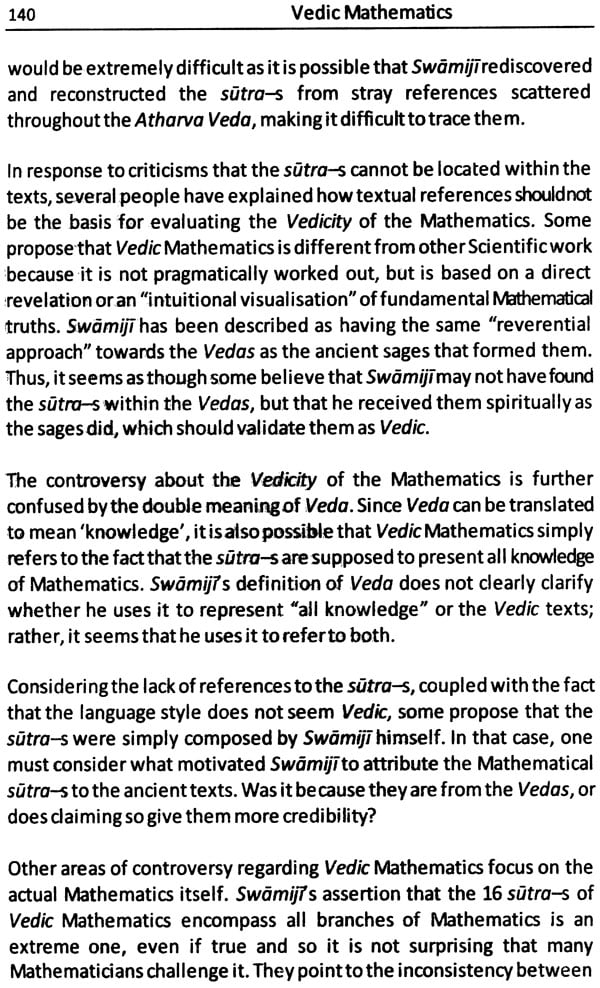
Vedic Mathematics (30 Formulae Elucidated)
Book Specification
| Item Code: | NAG114 |
| Author: | Dr. Ramamurthy N |
| Publisher: | CBH Publications |
| Language: | English |
| Edition: | 2014 |
| ISBN: | 9789382237099 |
| Pages: | 160 |
| Cover: | Paperback |
| Other Details | 8.5 inch X 5.5 inch |
| Weight | 160 gm |
Book Description
Vedic Mathematics is not only a sophisticate pedagogic and research tool but also an introduction to an ancient civilization. Rooted in the ancient Vedic sources which heralded the dawn of human history and illumined by their erudite exegesis, India’s intellectual, scientific and aesthetic vitality blossomed and triumphed not in only in Astronomy, Arithmetic, Geometry, Algebra, and Various Sciences, but also in Philosophy and Performing arts. Vedic Mathematics was introduced to the world community around 50 years ago, has found a lot of potential and wealth in it. With more and more excavations in this subject, quiet a lot of complicated calculations/ applications are made simple and easy. It is seen in any standard book on Vedic Mathematics the different types of problems are considered and solutions provided using one or more of the formulae or corollaries. However, in this book each of the formulae/ corollary has been individually explained with example (s). This makes this book a unique of its kind.
Dr. Ramamurthy, has been in the forefront of imparting knowledge based studies in the areas of Vedas, Samskrit, Banking, related IT solutions, information security, IT Audit and so on. His thirst for continuous learning does not subside. He did research on an unique topic “information Technology and Samskrit” and obtained Ph. D.-doctorate degree from University of Madras even at the age of late fifties. He has so far penned 18 books on religious literature, software Testing and Banking topics. Currently he is working on a project of developing a Samskrit based compiler.
Dr. Ramamurthy, has been in the forefront of imparting knowledge based studies in the areas of Vedas, Samskrit, Banking, related IT solutions, Information Security, IT Audit and so on. His thirst for continuous learning does not subside. He did research on an unique topic “Information Technology and Samskrit” and obtained Ph.D. – doctorate degree from University of Madras even at the age of late fifties. He has so far penned 18 books on religious literature, Software Testing and Banking topics. Currently he is working on a project of developing a Samskrit based compiler.
When we study the ancient history of India we discover that there are many things that we can be proud of. While ancient India had a well- developed civilization, its contribution to the development of human thought was stupendous. These contributions are not only in the field of spiritual sciences, but also in the field of secular sciences like medicine, mathematics, astronomy, politics, economics, linguistics, dramatics, dance music, fine arts, chemistry, architecture, etc. without modern facilities, instruments, technology, etc. what they have achieved is indeed astounding. Unfortunately, most of these are recorded in Samskrit language and, therefore, inaccessible to the layman. However, a lot of research is being undertaken now-a –days and they are brought out for the appreciation of general public.
In the field of Mathematics the works of Aryabhatta l (5th Century C.E.), Brahmagupta (7th Century C.E.), Aryabhatta ll (10th Century C.E.) and Bhaskaracharya (12th Century C.E.) are acknowledged by many scholars of East and West.
In this series of contributions by Indians to the world of Mathematics “ Vedic Mathematics” is the latest addition. It is book written by HH Swami Bharati Krishna Teerthaji and was first published in 1965. It contains a list mental calculation techniques claimed to be based on the ancient Vedas. The mental calculation system mentioned in the book is popularly known by the name” Vedic Mathematics”. Although the book was first published in 1965, Teerthaji had been propagating the techniques since much earlier, through lectures and classes.
Vedic Mathematics is just around 50 years old and has lot of potential and wealth in it. With more and more research in this subject, quiet a lot of complicated calculations/applications can be made simple and easy.
This book of Sri Ramamurthy can be treated as a commentary for the Sutras of Vedic Mathematics written by Teerthaji. In other books on Vedic Mathematics, different types of problems are considered and solutions provided using one or more of the formulae or corollaries. However, in this book each of the formulae has been individually discussed and explained with example (s) in simple language so that it could be easily understood by any Mathematics student. The criticisms and replies to the criticisms are also dealt with along with some Management Perspective of Vedic Mathematics. Thus Sri Ramamurthy has done a commendable work through this book.
It is also understood that Sri Ramamurthy has written other books relating to Religion, information Technology, Banking, etc. May he succeed in all his endeavours. I pray God for his long lie and continuous service in spreading the knowledge.
Mathematics is the basis of all Sciences. Indian Mathematics is a universe in itself. Once stepped in, anyone will be steeped (submerged) into it. It is very difficult to decide which direction to pursue, which concept t o pick up, etc. we have heard of the glorious achieve ments of traditional Indian thinkers, Astronomers and Philosopher. We also know about the work of such intellectuals in the field of Mathematics. But most of us were not much aware that Mathematics was so common that it was used in the day-to-day activities of the common people. It is this simplicity of Indian Mathematics that fascinated everyone. Some of the basic techniques of Indian and Vedic Mathematics in various fields including the fairly recent field of Computer Science are really astonishing.
Vedic Mathematics is relatively new, around 50 years old and hence has lot of potential for study and elaboration. Having delved into Samskrit, anyone will be wonder struck with the huge treasure of knowledge hidden in our tradition.
Vedic Mathematics compiled by late HH Sankaracarya (Bharati Krsna Tirtha Swami) of Govardhan Pitha is a monumental work. In his deep layered explorations of cryptic Vedic mysteries relating especially to the calculations of laconic formulae and their near and ready application to practical problems, the late Sankaracary shows the rare combination of probing insight of reveling intuition of a Yogi with the analytic acumen and synthetic talent of a Mathematician.
Sri Bharati Krsna Tirtha Swamiji did not write Vedic Mathematics on his own. He got it in his mind through penance during later 1910s and gave us the treasure. This was known to us only in early 60s if 20th century C.E., i.e. nearly 50 years after his compiling the same.
The sixteen formulae of Vedic Mathematics correspond to sixteen vowels of Samskrit language. With vowels, all t he words are formed and without which no word can be found. Similarly any problem of Mathematics can be solved using one or more of the Vedic Mathematics formulae. Vedic Mathematics is itself called as “mental Mathematics”. This gives lot of work to the brain and the mind-leading to various thinking processes. Vedic formulae not only tell us how to do the Mathematical calculations by easy one line method and through rapid processes, but they also tabulate the results in the shape of special corollaries containing merely illustrative specimens with a master-key for “unlocking other portals” too.
Vedic Mathematics is not only a sophisticated pedagogic and research tool but also an introduction to an ancient civilization. It takes us back to many millennia of India’s Mathematical heritage. Rooted in the ancient Vedic sources which heralded the dawn of human history and illumined by their erudite exegesis, India’s intellectual, scientific and aesthetic vitality blossomed and triumphed not in only in philosophy, physics, Astronomy, ecology and performing arts but also in Geometry, Algebra and arithmetic.
It is understandable that because of some of the undernoted reasons students are scary and keep a distance from Vedic Mathematics:
One does not have equally good knowledge both in Mathematics and Samskrit as well.
It is so cryptic that decoding needs lot of thought and application of mind.
It does not have a uniform method for the same type of calculations for instance, in the case of normal multiplication we have tables to use and for all the multiplication problems we use the same tables. However, in the case of Vedic Mathematics different formulae are used for the numbers ending with ‘9’ or ‘5’, etc.
Vedic Mathematics also triggers the Management Science angle that stimulate the thought of “differently thinking”, “diagonally thinking”, “vertically thinking”, etc. All these thought processes are needed for effective Management. All these are used widely and with a purpose in computer Project/ Program Management also.
Normally it is seen, in any standard text book on Vedic Mathematics, different types of problems are considered and solutions provided using one or more of the formulae or corollaries. However, each of the formulae/ corollary has been individually explained with example (s). This makes this book a unique of its kind.
Vedic Mathematics is just around 50 years old and has lot of potential and wealth in it. With more and more excavation in this subject, quiet a lot of complicated calculations/ applications can be made simple and easy. We can with confidence believe that if we look at Vedic Mathematics more closely enough, there is still many a thing left to learn and explore.
Conventions used in this book: The transliterated Samskrit words are written in italics-for instance Vedic. When Samskrit words are transliterated in English diacritical marks are used to correctly pronounce the words. However the same has not been used in its entirely in this book, since it makes the reading a little more difficult and since this book is intended for common audience.
My humble pranams to HH Swami Paramarthananda, who has written the foreword to this edition.
I will be failing in my duty, if I do not thank Sree. M. Easwaran, who has got this book printed and published. He has reviewed the book and gave nice feedback so that the book is in this fashion. Nice job done- thanks a lot. Sincere thanks are due to all those who supported in this noble cause.
The readers are requested to give all comments and feedback to the author.
| Dedication | 5 | |
| Foreword | 6 | |
| 1 | Vedic Mathematics | 8 |
| 1.1 | Salient Features of Vedic Mathematics | 11 |
| 1.2. | Formulae and Corollaries of Vedic Mathematics | 13 |
| 2 | Sutra1: - Ekadhikena Purvena | 15 |
| 3 | Sutra2:- Nikhilam Navatascaramam | 21 |
| Dasatah | ||
| 4 | Sutra 3:- Urdhvatiryagbhyam | 26 |
| 5 | Sutra4: Paravartya Yojayet | 32 |
| 6 | Sutra 5: -Sunyamm Samyasamuccaye | 36 |
| 7 | Sutra6: -(Anurupye) Sunyamanyat | 40 |
| 8 | Sutra7: - Sankalana-Vyavakalanabhyam | 45 |
| 9 | Sutra8:- Puranapuranabhyam | 47 |
| 10 | Sutra9:-Calanakalanabhyam | 49 |
| 11 | Sutra10:- Yavadunam | 51 |
| 12 | Sutra11:-Vyastisamastih | 53 |
| 13 | Sutra12:-Sesanyankena Caramena | 61 |
| 14 | Sutra13:- Sopantyadvayamantyam | 62 |
| 15 | Sutra14:-Ekanyunena Purvena | 65 |
| 16 | Sutra15:- Gunitasamuccayah | 69 |
| 17 | Sutra16:- Gunakasamuccayah | 74 |
| 18 | Corollary1- Anurupyena- proportionately | 75 |
| 19 | Corollary2- Sisyate Sesasamjnah | 79 |
| 20 | Corollary3- Adyamadyena | 83 |
| Antyamantyena | 85 | |
| 21 | Corollary4- Kevalaih Saptakam Gunyat | 89 |
| 22 | Corollary5- Vestanam | 91 |
| 23 | Corollary6- Yavadunam Tavadunam | 100 |
| 24 | Corllary7- Yavadunam Tavadunikrtya Varganca Yojayet | 102 |
| 25 | Corollary8-Antyayordasake'pi | 106 |
| 26 | Corollary9-Antyayoreva | 108 |
| 27 | Corollary10- Samuccayagunitah | 112 |
| 28 | Corollary11-Lopanasthapanabhyam | 113 |
| 29 | Corollary12-Vilokanam | 118 |
| 30 | Corollary13-Gunitasamuccayah Samuccayagunitah | 122 |
| 31 | Corollary 14- Dvajada or Dvajanka | 124 |
| 32 | Vedic Mathematics-A Management Perspective | 127 |
| 32.1 | Observation | 129 |
| 32.2 | Division(Segmentation) | 130 |
| 32.3 | Addition | 131 |
| 32.4 | Subtraction | 133 |
| 32.5 | Variation | 134 |
| 32.6 | Rotation | 135 |
| 32.7 | Equation (Comparison) | 137 |
| 32.8 | Summary | 138 |
| 33 | Criticism on Vedic Mathematics | 139 |
| 33.1 | Some replies to the criticisms | 141 |
| 33.2 | Summary | 145 |
| Annexure1 | 146 | |
| Annexure2 | 153 | |
| Bibliography | 158 |
